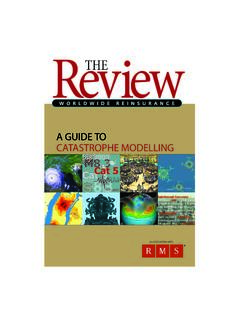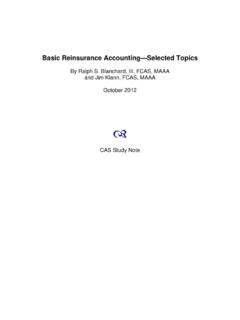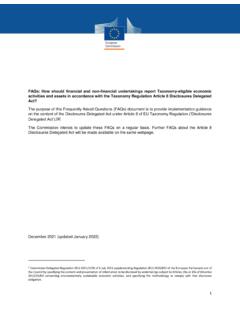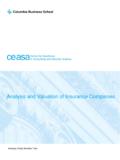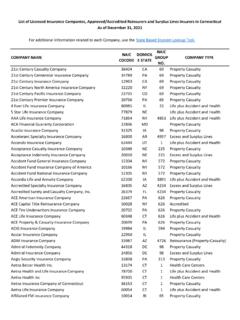Transcription of A Guide to Catastrophe Modeling - RMS
1 A Guide TO Catastrophe MODELLINGIN ASSOCIATION WITHCat modelling Guide 2008 5/12/08 17:33 Page 12 The Review A Guide to Catastrophe Modelling 2008 Catastrophe MODELLING: A STEP-BY-STEP EXAMPLE1. User enters location data and building characteristics into modelThe basic framework for modelling perils is similar. Thisexample illustrates the steps a user would take to arrive atan estimation of modelled losses from hurricane risk to agiven location. 2. Model geocodes location to its geographic coordinates, identifying location s distance to coast 3. Stochastic event module defines event set for specified location and storm type4. Hazard module generates event information including wind speedand storm surge to determine hazard intensity5. Vulnerability module retrieves hazard intensity and generates average damage (ie, mean damage ratio) andassociated uncertainty factoring in building characteristics (eg, roof type, construction type)6.
2 Based on the estimated mean damage ratio and uncertainty, financial module calculates losses based on building values andinsurance policy terms7. financial loss is quantified for specified coverage(s) and line(s) of business based on the mean damage ratio and its modelling Guide 2008 5/12/08 17:33 Page 2 The Review A Guide to Catastrophe Modelling 20083 CONTENTS4 EditorialbyRuth Lythe, Deputy Editor of The Introductionby Hemant Shah, President and CEO of 16 Catastrophe modelling fundamentalsCatastrophe models can trace their roots back to the 1800s but today s sophisticated techniques are helping to manage 21st century risks. Patricia Grossi and Cheryl TeHennepe 210 Catastrophe modelling applicationsJosh Ellingsonand Matthew Novakexamine hurricanemodelling; Sahar Safaie and Chesley Williams look atmodelling earthquake risk; while Maria Lameloexplainsterrorism 312 Exposure data qualityHurricane Katrina propelled the importance of accurateexposure data to the top of the boardroom agenda, where itmust remain, say Ajay Lavakareand Kenna 415 Risk mitigation and policyRe/insurers must embrace risk mitigation if they are to weatherthe host of challenges facing the industry in the long-term, sayCeline Herweijer, Nicola Patmore, Bob Wardand 518 Capital marketsThe potential of transferring cat risk to the capital markets is yetto be fully tapped, say John Stroughairand Ben 621 New risk modelling frontiersThe cat modelling world is expanding its horizons to cover an even broader array of risks in the future, explainsRobert Review is published 10 times a year by InformaUK Ltd, Telephone House 69-77 Paul Street, London,EC2A 4LQ, UKDistributed by MSC Mailers, Inc.
3 420 South Ave, Middlesex, NJ 08846. Periodical PostagePaid at Middlesex, NJ 08846 POSTMASTER: Send USaddress corrections to Pronto Mailers Association, 444 Lincoln Blvd, Middlesex NJ also publishes Health Insurance, World Insurance Report and Insurance : Greg DobieEmail: Editor: Ruth LytheEmail: reporter: Sarah Editor: Nicki SitarasEmail: Manager: Paul Clifton Director: Andrea Unless otherwise indicated all images copyright RMSP rinter: Paterson PrintingSubscription enquiries: Customer Services Department,Informa UK Ltd, Sheepen Place, Colchester. CO3 3LP. Tel: +44 (0)20 7017 5532 Fax: +44 (0)20 7017 4781 Annual subscription to The Review: UK 488; Europe 598; US/rest of world : $804 Neither the publisher nor the sponsor accept any responsibility for any inaccuracies, errors or omis-sions contained in this publication. Interested partiesshould rely on their own enquiries.
4 2008 Informa UK Ltd. All rights reserved; nopart of this publication may be reproduced, storedin a retrieval system, or transmitted in any form orby any means, electrical, mechanical, photocopy-ing, recording or otherwise without the prior writ-ten permission of the Guide TO Catastrophe MODELLING2008/09IN ASSOCIATION WITHA Guide to Catastrophe ModellingCat modelling Guide 2008 5/12/08 17:33 Page 3 From floods in Australian mines, to the devastation leftbehind by Hurricane Ike, 2008 was an active year forinsured Catastrophe with the close of the North Atlantic hurricane season,the toll of natural disasters across the world continues tosteadily all accounts, we should steel ourselves for more of the same in figures from one leading reinsurer put weather-related insuredlosses at a projected $40bn a year by course the impact of global warming must be factored into theequation, adding to the increasing numbers of climate-linked events andtheir , growing risks from terrorism, earthquakes and epidemicsmean that in the near future insured Catastrophe losses may hit over$100bn in severe if all that wasn t enough to contend with.
5 Another peril has beenrecently making its presence truly felt in the global credit markets that ofthe financial a world of increasing uncertainty one thing is sure bigger and morefrequently occurring catastrophes are set to test the mettle of modellingcompanies in the the past century, Catastrophe modelling technology has progressedfrom little more than a collection of maps to the cutting edge application wesee today. But in the modern world, issues such as exposure data quality and riskmitigation have moved to the forefront, urgently requiring the attention ofboth re/insurers and , risk managers must contend with a mind-boggling array of perilsfor which they must attempt to make the best possible , the art and methodology of modelling has never been sosharply under focus from all such an environment, this Guide s illuminating insight into the world ofmodels and explanation of how they can aid with an ever shifting spectrumof risk, is most LytheDeputy EditorThe Review Worldwide ReinsuranceEDITORIAL4 The Review A Guide to Catastrophe Modelling 2008A shifting spectrumCat modelling Guide 2008 5/12/08 17.
6 33 Page 4 INTRODUCTIONThe Review A Guide to Catastrophe Modelling 20085 The human and financial consequences of catastrophes whetherthese are earthquakes, hurricanes or floods, disease pandemics orterrorist attacks can be devastating. However, risks are rising, as popu-lations grow along exposed coastlines and mega-cities rapidly expand,and a warmer climate affects the frequency of some extreme events, suchas wildfires and flash floods, as well as the intensity of hurricanes. Catastrophic risks are inherently challenging to model, due to the limitedknowledge about what determines the probability of extremeevents occurring, and the need to understand all the potentialpathways to loss. But models provide a mechanism to integrateand synthesise all the relevant science, data, engineeringknowledge and even behaviour of claimants and insurers in theaftermath of a Catastrophe .
7 They also provide an environmentand toolset in which all this knowledge can then be harnessed byre/insurers, property owners and policymakers to make informedrisk management and mitigation decisions. While originallyfocused on managing risks in countries with establishedinsurance industries, Catastrophe models are also being used today to help create new risk transfer mechanisms in the developing world. Uncertainty lies at the heart of risk modelling, and demands an appreciation at allstages, including in the quality and completeness of the exposure data fed into themodels and in the interpretation of model results. The more that users of catastrophemodels understand about how they are developed and calibrated, and the quality ofthe data on insureds, the better enabled they are to make informed decisions on howto stress test their pricing and accumulation strategies.
8 This Guide aims to outline the foundations of Catastrophe modelling by providingbackground information on how specific perils are modelled, as well as how theresulting loss metrics are used by re/insurers. It traces Catastrophe modelling from itsresearch beginnings to its present status as a core business application, and coverskey issues related to best practice in the use of models within the world ofre/insurance. For those in the industry who are aware of cat models, but are notfamiliar with the concepts or applications, I hope this provides an introduction to howprobabilistic models can aid in making better risk management decisions for eventswe cannot predict but can prepare ShahPresident and CEO RMSL earning lessons from the unexpectedThe more that users ofcatastrophe modelsunderstand about howthey are developed andcalibrated, the betterenabled they are tomake informeddecisions on how tostress test their pricingand accumulationstrategiesCat modelling Guide 2008 5/12/08 17:33 Page 5 ORIGINS OF CATASTROPHEMODELLINGC atastrophe modelling has itsorigins both in the field ofproperty insurance and in thescience of natural hazards.
9 Inthe 1800s, residential insurerscovering fire and lightning riskused pins on a wall-hung mapto visualise concentrations ofexposure. The common practiceof mapping ended in the 1960swhen it became toocumbersome and timeconsuming to execute. The origin of catastrophemodelling also lies in themodern science ofunderstanding the nature andimpact of natural hazards. Inparticular, the common practiceof measuring an earthquake smagnitude or a hurricane sintensity is one of the keyingredients in a catastrophemodel. A standard set ofmetrics for a given hazard mustbe established so that risks canbe assessed and managed. Thismeasurement began in the1800s as well, when the firstmodern seismograph,measuring earthquake groundmotion, was invented andmodern versions of theanemometer, measuring windspeed, gained two separatedevelopments mapping riskand measuring hazard cametogether in a definitive way inthe late 1980s throughcatastrophe models formeasuring Catastrophe losspotential were developed bylinking scientific studies ofnatural hazard measurementsand historical occurrences withadvances in informationtechnology and geographicinformation systems (GIS).
10 While the birth ofprobabilistic Catastrophe riskmodelling occurred in the late1980s, the use of suchsophisticated, technical meansof monitoring risks was notwidely accepted untilHurricane Andrew madelandfall in Southern Florida in1992. As a result of theunprecedented losses,insurance companiesstruggled to stay in businessand Catastrophe riskmanagement was changedforever. It became clear that aprobabilistic approach to lossanalysis was the mostappropriate way to managecatastrophe risk. HurricaneAndrew illustrated that theactuarial approach tomanaging Catastrophe riskwas insufficient; a moresophisticated modellingapproach was needed. Today, Catastrophe modelsare prevalent throughout theinsurance industry, assistingre/insurers and otherstakeholders in managingtheir risk from both naturalperils and more recently, man-made catastrophes, across theglobe.
